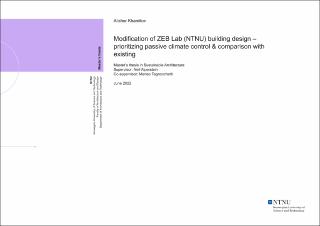| dc.description.abstract | Sustainability is one of the fast-developing trends in every aspect of our lives, each year demand and goals for making less pollution of the environment is increasing. Thus, buildings as one of the highest pollutants must be not only, reconsidered as a way of construction materials and energy consumption, but also kept up with the stricter sustainable standards which appears each year, to reach the highest ZEB (Zero Emission Building) goals.
Study will include redesign of existing ZEB building, which is located in NTNU Gløshaugen campus in Trondheim. A ZEB Laboratory is an experimental facility, it plays role as a testing place of new technologies on a larger scale. The ambitions of that building is to achieve ZEB–COM level in 60 years perspective.
This thesis aims to unveil new possibilities of passive strategies together with finding better combinations with active ones to decrease building’s energy consumption, with keeping or improving indoor comfort. Main goal is to reach the ZEB-COM level with using same amount of material or less, with the same area of the building, and implementation of new or improving existing passive strategies. There will be simulations of different possible modifications of form of ZEB Laboratory, with their pros and cons in comparison with existing one, to find the best possible shape in terms of energy consumption and PV production.
In the end there will be two proposed shapes in comparison with existing one. First form is called “Big North” will have lesser energy consumption and similar PV production as the existing one, with the ZEB Balance calculation of (-0,22) in comparison with existing (-0,17), both reached ZEB-COM level. Then the second form “Small North” will have even lower energy consumption due to the shape, however much smaller PV production, which will lead to not reaching ZEB-COM (0,66).
At the level of a ZEB-COM building it is difficult to introduce changes which would make a significant difference. As one can see from the results, the improvements are small in relation to the existing ZEB lab, but it is possible to make improvements with replanning of windows placements, reducing of material usage and modifying passive strategies. My research shows that one can achieve some improvements by prioritizing passive strategies in the context of finding a balance between passive and active strategies. | |
